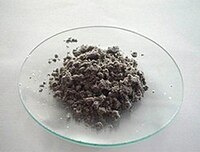
Photo from wikipedia
Boronizing (boron diffusion) is an important surface modification treatment applied to improve surface properties of metals, especially steels. An interstitial-free (IF) steel was boronized in this study. Boronizing was carried… Click to show full abstract
Boronizing (boron diffusion) is an important surface modification treatment applied to improve surface properties of metals, especially steels. An interstitial-free (IF) steel was boronized in this study. Boronizing was carried out electrothermochemically at 900, 960, and 1020°C temperatures by applying an electric current at 0.10, 0.20, 0.30, and 0.40 A/cm2 current densities for 15, 30, 45, 60, and 90 min in a salt bath containing 100 % Na2B4O7. The microstructures of the generated boride layers were investigated by utilizing an optical microscope and a scanning electron microscope equipped with an energy dispersive spectrometer, while the phase analyses were carried out using an X-ray diffractometer (XRD). Thickness of the boride layers was measured visually on the micrographs that were taken during the microstructural investigations. Square thickness of boride layer versus time was derived for selected temperature-current density parameters. Coefficient of diffusion was calculated for the experimental conditions by applying the related equation. Change of coefficient of diffusion with temperature was presented in a diagram for given current density values; by using the slope of the line in this diagram, diffusion activation energy was evaluated to be between 80.70 and 100.16 kJ per mole depending on the current density applied during boronizing.
Journal Title: Materials Performance and Characterization
Year Published: 2017
Link to full text (if available)
Share on Social Media: Sign Up to like & get
recommendations!